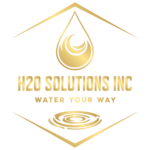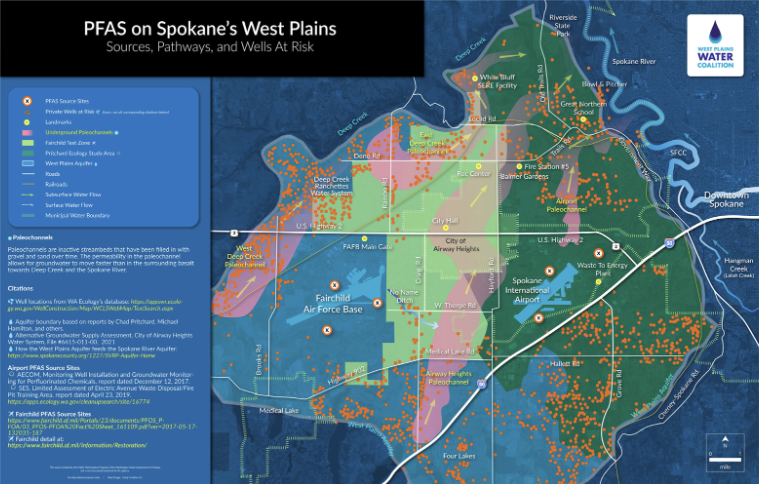PFAS Contamination in Airway Heights
A Guide to PFAS and Water Quality in Airway Heights
The Timeline of PFAS Contamination in Airway Heights
1970's Firefighting Foam
PFAS Exposure Findings
PFAS Added to EPA Contaminants
2016 Firefighting Foam
Military Base Testing
Fairchild Airforce Base PFOS Contamination
Airway Heights Switches to Spokane Water
GAC Treatment Installed in Airway Heights
PFAS Firefighting Foam Bill
PFAS Exposure Study
Long-Term Solution Funding
SEPA Review Notice
2019 Exposure Assessment
Mitigated Determination of Non-Significance
Spokane Airport PFAS Contamination
EPA Funds Water Testing
Understanding PFAS: What Makes Them Hazardous?
What is PFAS?
PFAS, short for perfluoroalkyl and poly-fluoroalkyl substances, is prevalent in everyday items like fire-extinguishing foam and other products that resist grease, water, and oil. These non-stick persistent compounds, often dubbed “forever chemicals,” resist environmental breakdown and lead to bioaccumulation in human bodies.
Research
In scientific research, PFAS exposure has been associated with various health concerns, including fertility complications, heightened cancer risks, and endocrine disruption. Perfluorooctane sulfonate (PFOS) and perfluorooctanoic acid (PFOA) represent two prevalent types of PFAS found extensively across soil, air, and groundwater in the United States. As a result, health districts routinely conduct tests specifically targeting these compounds.
Water Quality of the City of Airway Heights |
14 Contaminants Detected
As of March 2021, eight potentially cancerous contaminants were detected above the Environmental Working Group (EWG) health guidelines.
| Water Contaminants Detected | Level in Water | EWG Guideline | Exceed EWG Guidelines |
|---|---|---|---|
| Arsenic | 0.600 ppb | 0.004 ppb | 150x EWG's health guideline |
| Bromodichloromethane | 0.393 ppb | 0.06 ppb | 6.5x EWG's health guideline |
| Chloroform | 1.43 ppb | 0.4 ppb | 3.6x EWG's health guideline |
| Dibromochloromethane | 0.223 ppb | 0.1 ppb | 2.2x EWG's health guideline |
| Nitrate | 2.26 ppm | 0.14 ppm | 16x EWG's health guideline |
| Nitrate and nitrite | 1.41 ppm | 0.14 ppm | 10x EWG's health guideline |
| Radium, combined (-226 & -228) | 0.63 pCi/L | 0.05 pCi/L | 13x EWG's health guideline |
| Total trihalomethanes (TTHMs) | 3.79 ppb | 0.15 ppb | 25x EWG's health guideline |
Updated as of May 16 from https://www.ewg.org/tapwater/system.php?
Is Your Water Affected? We Help Reveal the Answers
The guidelines for PFOS and PFOA levels in drinking water have evolved significantly. While the 2016 standards set a threshold of 70 parts per trillion (ppt) for both compounds, the latest 2022 guidelines have dramatically reduced this to 0.02 ppt for PFOS and 0.004 ppt for PFOA. This stark contrast, therefore, underscores the growing concern over even trace amounts of these contaminants in our water supply. Fortunately, however, you can proactively ensure your water meets these stringent standards.
Our Commitment with Airway Heights
We aim to deliver the highest-caliber water solutions to our community, while also providing unparalleled customer service and comprehensive warranty coverage. In doing so, we ensure our customers receive both top-quality products and reliable support.
Our Story with the Pacific Northwest
H2O Solutions offers educational resources, filtration systems, and maintenance services across the Pacific Northwest to effectively address each home's unique water quality challenges. As a result, we provide tailored solutions that meet the specific needs of every household.
Our Guiding Principles
We take pride in our dedication to our community and employees, as we strive to fulfill the right to clean and healthy water through affordable solutions. In doing so, we ensure that both our customers and team members benefit from our commitment to quality and care.
How to Have Safe Drinking Water During the PFAS Water Crisis
Health districts, including the Environmental Protection Agency (EPA), are urgently investigating the extent of water contamination in Western Spokane County. In the meantime, you must take independent steps to ensure the safety of your drinking water. By doing so, you can safeguard yourself and your loved ones with healthy drinking water that you can trust.
The EPA recommends these specific types of water filters known to reduce PFAS contamination effectively:
- Granular Activated Carbon (GAC)
- Reverse Osmosis (RO) systems
- Ion Exchange Resins
Remember the 14 contaminants the water of the city of Airway Heights have? If you want your water to be completely safe to drink, here are the filters based on what other contaminants they can remove.
| Contaminants Above EWG Health Guidelines | Granular Activated Carbon | Reverse Osmosis | Ion Exchange Resins |
|---|---|---|---|
| Arsenic | Yes | Yes | |
| Bromodichloromethane | Yes | Yes | |
| Chloroform | Yes | Yes | |
| Dibromochloromethane | Yes | Yes | |
| Nitrate | Yes | Yes | |
| Nitrate and nitrite | Yes | Yes | |
| Radium, combined (-226 & -228) | Yes | Yes | |
| Total trihalomethanes (TTHMs) | Yes | Yes | |
| Barium | Yes | Yes | |
| Bromoform | Yes | Yes | |
| Chromium (total) | Yes | Yes | |
| Fluoride | Yes | Yes | |
| Manganese | Yes | ||
| Trichloroethylene | Yes | Yes |
Ensure the Water Filter System’s PFAS-Reducing Water Certification
Whatever type of water filter you choose, be sure to check if it has the NSF/ANSI 53 or NSF/ANSI 58 standards for PFAS reduction. This, in turn, will give you peace of mind regarding the quality of your drinking water. Additionally, explore our Residential and Commercial Water Systems, which we can install for you.
Taking Action: Ensuring Clean Drinking Water for Today and Tomorrow
In the wake of the revelation of elevated PFAS levels in Airway Heights’ groundwater wells, proactive measures are, therefore, essential to safeguarding the water quality of both homes and communities. To address this, here’s a roadmap for action in removing contaminated water
Get a Water Quality Analysis
Install a Certified PFAS-Reducing Water Filter
Enjoy Healthy Drinking Water


